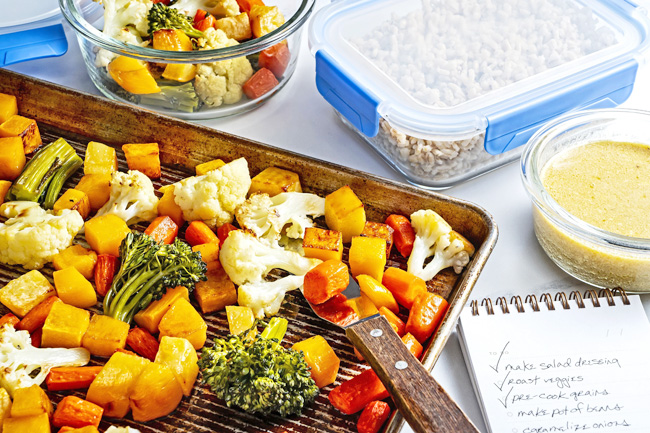Aaron Hutcherson
THE WASHINGTON POST – As lovely as the idea of eating food cooked from scratch “a la minute” for every meal sounds, it is entirely out of reach for all except the most privileged in terms of time and/or resources.
But all is not lost for the rest of us. You might be familiar with meal planning, but a close relative is meal prepping, which involves crossing a few tasks off the week’s cooking to-do list to make getting food on the table in the days that follow much simpler – and in many instances more flavourful.
While you are certainly welcome to plan out what you want to eat for the coming week, there are general tasks you can do ahead of time that will set you up for success no matter what you ultimately choose to make.
Perhaps you’re the type of cook who starts every dish by sauteing a diced onion. Maybe you are planning to have a salad or grain bowl tossed with your favourite dressing for lunch every week. Or perchance you’re of the know that whenever there are cooked beans at your disposal, dinner can be mere minutes away.
If so, taking care of chopping a bunch of onions, mixing a batch of salad dressing or simmering a pot of legumes one afternoon will get you one step closer to your goal.
Meal prep is all about increasing efficiency to make the most of your time in the kitchen.
Here are 10 tasks you can complete to help feed your household with ease.

MAKE SALAD DRESSING
Salad dressings are a simple way to add pizazz to not only greens and lettuces, but also grain bowls, cooked vegetables, proteins (such as grilled chicken breasts or steamed fish) and more.
Sure, a basic vinaigrette requires only a handful of ingredients and a quick whisk (or my preferred method: a few shakes in a Mason jar), but why do it more times than you need to? Make one batch and pull it out of the fridge whenever you want to toss a salad or add an extra punch of flavour to your plate.
ROAST VEGGIES
Roasting is by far my favourite way to prepare vegetables. I love when they get nicely browned or even a bit charred in spots so much that I could eat – and have eaten – roasted veggies straight off a sheet pan as my meal.
But beyond that, having them on hand to add to grain bowls or salads or to serve as a side accompanying a protein or carb can save you so much time and energy.
COOK A POT OF GRAINS OR LEGUMES
Grains and legumes are easy ways to add heft and substance to a meal – if not essentially be the meal itself. (I have no qualms with eating a bowl of beans for lunch or reheating rice to top with kimchi for dinner).
But cooked rice, beans, and other grains and legumes are useful ingredients in various recipes, such as fried rice or any dish where you might usually use canned beans.
GRATE CHEESE
“Bagged shredded cheese typically includes additives that prevent clumping. Unfortunately, they can also prevent melting,” my colleague Becky Krystal wrote. “If you want the best ooey, gooey texture for grilled cheese or mac and cheese, grate your own, using a box grater or your food processor.” Then store it in the fridge, where it should last a few days.
TOAST NUTS
Toasted nuts are an easy way to add texture to any bowl or plate. Sure, you could buy already roasted nuts, but they are never quite as toasted as I’d like them to be – and therefore not as nutty. Doing it yourself means that you can make your nuts as crispy, crunchy and flavourful as your heart desires. Plus, you can season the nuts with your favourite spices to add even more interest.
MAKE CROUTONS OR FLAVOURED BREADCRUMBS
Speaking of texture, croutons and breadcrumbs are other examples where toasting them yourself might make you wish you always had the homemade versions around. You can add the croutons to salads, soups and stews, and use seasoned breadcrumbs to sprinkle atop veggies, pasta and whatever else you can think of.
MIX COMPOUND BUTTERS
Compound butter is just a fancy term for butter that has been flavoured with any number of ingredients. “Classic additions, separately or together, are garlic, parsley and shallot,” Krystal wrote in her primer on the subject.
“Citrus is a natural, too, whether it’s zest, juice or even something like preserved lemon or lemon confit. The possibilities with dried spices are almost endless.”
When it comes to uses, the possibilities are endless, too. Compound butter works as an ingredient – use it to toast croutons, make garlic bread, whisk into pan sauces, etc – or a finishing touch – such as to melt over seared beef, roasted vegetables or your favourite pancakes.
PICKLE VEGGIES (OR FRUIT!)
Keeping a jar – or five – of pickles in your fridge is always a good idea. While cucumbers are the default, the world of pickling is vast: You can pickle rhubarb, cauliflower, grapes, raisins, jalapeños, onions and so much more!
Mix them in with salads and grain bowls; add them to sandwiches, burgers and tacos; use them as a topping for pizza; or eat them as a snack or when you’re fending for dinner. The world is your oyster pickle.
MAKE BREAD DOUGH
I get it, baking bread can be intimidating, but if you’re looking for an easy entry point, focaccia is a great place to start.
You can bake it as is to serve with soups and stews or make sandwiches, or use the dough as a base for pizza.







